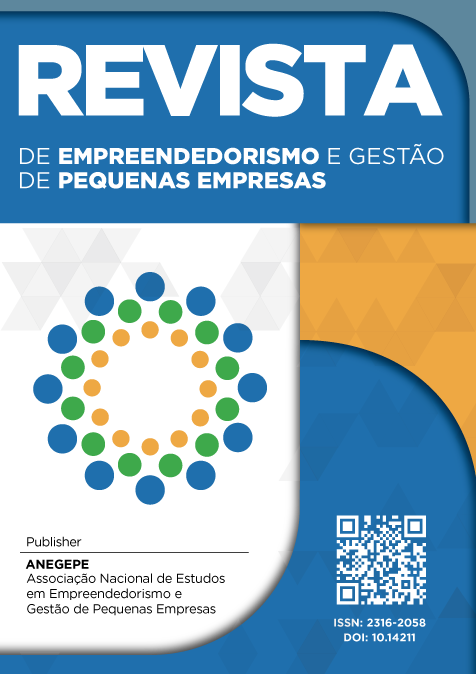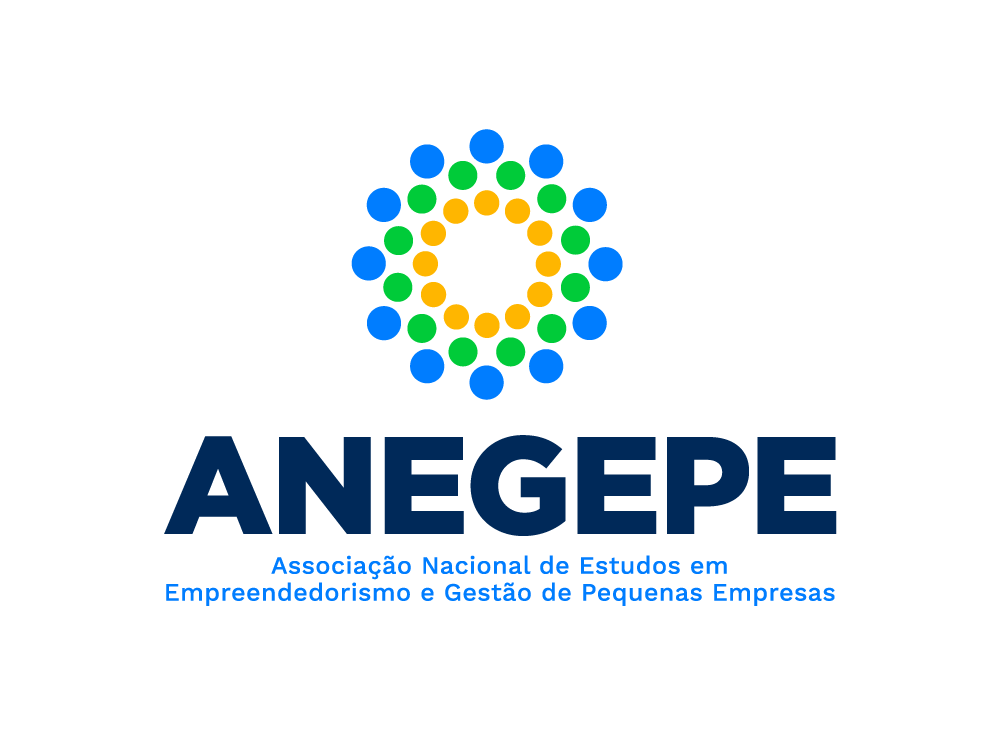Forms of capital, innovation capability and innovation in new ventures
DOI:
10.14211/ibjesb.e1952Keywords:
resources, innovation capability, innovation, entrepreneurship, PSEDAbstract
Objective: Investigate the impact of human, social, and financial capital on the variation of innovation capability of nascent ventures over time. Methodology/design: Quantitative research, developed using a longitudinal secondary database (Panel Study of Entrepreneurship Dynamics 2 - PSED 2). Multiple linear regression technique was used to test the research hypothesis. Main results: Among all types of capital analyzed in the study, level of education, personal finances, and physical social capital were determinant of the nascent ventures’ capability of developing innovation over time. Innovation capability influenced the creation of innovation, as well. Theoretical/methodological contributions: Considering the longitudinal design, the research presents which types of capital are relevant along time for nascent ventures to develop innovation capabilities. Relevance/originality: From the methodological perspective, the research has a longitudinal design, as suggested by entrepreneurship and innovation capability scholars since both phenomena are process oriented. It also differentiates innovation and innovation capability, which are two constructs used interchangeably by research, although being different. Social/management contributions: The results contribute to qualify which resources of a company in its initial phase have greater potential for generating long-term innovation.
Downloads
References
Akhavan, P., & Hosseini, S. M. (2016). Social capital, knowledge sharing, and innovation capability: An empirical study of R&D teams in Iran. Technology Analysis & Strategic Management, 28(1), 96–113. https://doi.org/10.1080/09537325.2015.1072622
Arvanitis, S., & Stucki, T. (2012). What determines the innovation capability of firm founders? Industrial and Corporate Change, 21(4), 1049–1084. https://doi.org/10.1093/icc/dts003
Barnir, A. (2012). Starting technologically innovative ventures: Reasons, human capital, and gender. Management Decision, 50. https://doi.org/10.1108/00251741211216205
Bayon, M. C., Lafuente, E., & Vaillant, Y. (2016). Human capital and the decision to exploit innovative opportunity. Management Decision. https://doi.org/10.1108/MD-04-2015-0130
Boyer, T., & Blazy, R. (2013). Born to be alive? The survival of innovative and non-innovative French micro-start-ups. Small Business Economics, 42(4), 669–683. https://doi.org/10.1007/s11187-013-9522-8
Breznik, L., & D. Hisrich, R. (2014). Dynamic capabilities vs. innovation capability: Are they related? Journal of Small Business and Enterprise Development, 21(3), 368–384. https://doi.org/10.1108/JSBED-02-2014-0018
Brown, J. R., Martinsson, G., & Petersen, B. C. (2017). Stock markets, credit markets, and technology-led growth. Journal of Financial Intermediation, 32, 45–59. https://doi.org/10.1016/j.jfi.2016.07.002
Busenitz, L. W., & Barney, J. B. (1997). Differences between entrepreneurs and managers in large organizations: Biases and heuristics in strategic decision-making. Journal of Business Venturing, 12(1), 9–30. https://doi.org/10.1016/S0883-9026(96)00003-1
Calantone, R. J., Cavusgil, S. T., & Zhao, Y. (2002). Learning orientation, firm innovation capability, and firm performance. Industrial marketing management, 31(6), 515-524. https://doi.org/10.1016/S0019-8501(01)00203-6
Camargo Filho, A. C., & Junior, C. V. B. (2019). Impact of Marketing Activities in the Early Years of a Firm’s Life on Its Future Performance. Revista de Empreendedorismo e Gestão de Pequenas Empresas, 8(1), 01–23. https://doi.org/10.14211/regepe.v8i1.1263
Cao, X., & Im, J. (2018). Founder human capital and new technology venture R&D search intensity: The moderating role of an environmental jolt. Small Business Economics, 50(3), 625–642. https://doi.org/10.1007/s11187-017-9911-5
Cerqueti, R., Lucarelli, C., Marinelli, N., & Micozzi, A. (2020). Teams in new ventures: Gender, human capital and motivation. International Journal of Gender and Entrepreneurship, 12(2), 145–171. https://doi.org/10.1108/IJGE-07-2019-0115
Chavis, L. W., Klapper, L. F., & Love, I. (2011). The Impact of the Business Environment on Young Firm Financing. World Bank Economic Review, 25(3), 486–507. https://doi.org/10.1093/wber/lhr045
Colombelli, A., Krafft, J., & Vivarelli, M. (2016). To be born is not enough: The key role of innovative start-ups. Small Business Economics, 47(2), 277–291. https://doi.org/10.1007/s11187-016-9716-y
Colombo, M. G., & Grilli, L. (2005). Founders’ human capital and the growth of new technology-based firms: A competence-based view. Research Policy, 34(6), 795–816.
https://doi.org/10.1016/j.respol.2005.03.010
Colombo, M. G., & Grilli, L. (2007). Funding Gaps? Access To Bank Loans By High-Tech Start-Ups. Small Business Economics, 29(1–2), 25–46. https://doi.org/10.1007/s11187-005-4067-0
Djoumessi, A., Chen, S.-L., & Cahoon, S. (2019). Deconstructing Lawson and Samson’s concept of innovation capability: a critical assessment and a refinement. International Journal of Innovation Management, 23(06), 1950053.
https://doi.org/10.1142/S1363919619500531
Dimov, D. (2010). Nascent Entrepreneurs and Venture Emergence: Opportunity Confidence, Human Capital, and Early Planning. Journal of Management Studies, 47(6), 1123–1153. https://doi.org/10.1111/j.1467-6486.2009.00874.x
Dziallas, M., & Blind, K. (2019). Innovation indicators throughout the innovation process: An extensive literature analysis. Technovation, 80–81, 3–29. https://doi.org/10.1016/j.technovation.2018.05.005
Evald, M. R., Klyver, K. I. M., & Svendsen, S. G. (2006). The changing importance of the strength of ties throughout the entrepreneurial process. Journal of Enterprising Culture, 14(01), 1-26. https://doi.org/10.1142/S0218495806000027
Field A. (2009). Descobrindo a estatística usando o SPSS. Porto Alegre: Artmed-Bookman.
Fuentelsaz, L., Maicas, J. P., & Montero, J. (2018). Entrepreneurs and innovation: The contingent role of institutional factors. International Small Business Journal, 36(6), 686–711. https://doi.org/10.1177/0266242618766235
Funken, R., Gielnik, M. M., & Foo, M.-D. (2020). How Can Problems Be Turned Into Something Good? The Role of Entrepreneurial Learning and Error Mastery Orientation. Entrepreneurship Theory and Practice, 44(2), 315–338. https://doi.org/10.1177/1042258718801600
Gartner, W.B., Frid, C.J. & Alexander, J.C. (2012) Financing the emerging firm. Small Business Economics, 39, 745–761. https://doi.org/10.1007/s11187-011-9359-y
Guo, R.-J., & Zhou, N. (2016). Innovation capability and post-IPO performance. Review of Quantitative Finance and Accounting, 46(2), 335–357. https://doi.org/10.1007/s11156-014-0471-3
Hechavarría, D. M., Matthews, C. H., & Reynolds, P. D. (2016). Does start-up financing influence start-up speed? Evidence from the panel study of entrepreneurial dynamics. Small Business Economics, 46(1), 137–167. https://doi.org/10.1007/s11187-015-9680-y
Herrmann, A. M., Storz, C., & Held, L. (2020). Whom do nascent ventures search for? Resource scarcity and linkage formation activities during new product development processes. Small Business Economics, 1-22. https://doi.org/10.1007/s11187-020-00426-9
Hii, J., & Neely, A. (2000). International Annual EurOMA Conference 2000 - Ghent, (June)
Hurley, R. F., & Hult, G. T. M. (1998). Innovation, Market Orientation, and Organizational Learning: An Integration and Empirical Examination. Journal of Marketing, 62(3), 42–54. https://doi.org/10.2307/1251742
Iddris, F. (2016). Innovation Capability: A Systematic Review and Research Agenda. Interdisciplinary Journal of Information, Knowledge, and Management, 11, 235–260. https://doi.org/10.28945/3571
Jonsson, S., & Lindbergh, J. (2013). The Development of Social Capital and Financing of Entrepreneurial Firms: From Financial Bootstrapping to Bank Funding. Entrepreneurship Theory and Practice, 37(4), 661–686. https://doi.org/10.1111/j.1540-6520.2011.00485.x
Kato, M., Okamuro, H., & Honjo, Y. (2015). Does Founders’ Human Capital Matter for Innovation? Evidence from Japanese Start-ups. Journal of Small Business Management, 53(1), 114–128. https://doi.org/10.1111/jsbm.12094
Khanin, D., & Turel, O. (2015). Conflicts and Regrets in the Venture Capitalist–Entrepreneur Relationship. Journal of Small Business Management, 53(4), 949–969. https://doi.org/10.1111/jsbm.12114
Koellinger, P. (2008). Why are some entrepreneurs more innovative than others? Small Business Economics, 31(1), 21–37. https://doi.org/10.1007/s11187-008-9107-0
Kou, M., Yang, Y., & Chen, K. (2020). The impact of external R&D financing on innovation process from a supply-demand perspective. Economic Modelling, 92, 375–387. https://doi.org/10.1016/j.econmod.2020.01.016
Laffineur, C., Dubard Barbosa, S., Fayolle, A., & Montmartin, B. (2020). The unshackled entrepreneur: Occupational determinants of entrepreneurial effort. Journal of Business Venturing, 35(5), 105983. https://doi.org/10.1016/j.jbusvent.2019.105983
Lawson, B., & Samson, D. (2001). Developing innovation capability in organisations: a dynamic capabilities approach. International Journal of Innovation Management, 05(03), 377–400. https://doi.org/10.1142/S1363919601000427
Marvel, M. R., Davis, J. L., & Sproul, C. R. (2016). Human Capital and Entrepreneurship Research: A Critical Review and Future Directions. Entrepreneurship Theory and Practice, 40(3), 599–626. https://doi.org/10.1111/etap.12136
Marvel, M. R., & Lumpkin, G. T. (2007). Technology Entrepreneurs’ Human Capital and Its Effects on Innovation Radicalness. Entrepreneurship Theory and Practice, 31(6), 807–828. https://doi.org/10.1111/j.1540-6520.2007.00209.x
Marzocchi, C., & Ramlogan, R. (2019). Forsaking innovation: addressing failure and innovation behaviour variety. Technology Analysis & Strategic Management, 31(12), 1462-1473. https://doi.org/10.1080/09537325.2019.1628937
McKelvie, A., & Davidsson, P. (2009). From Resource Base to Dynamic Capabilities: An Investigation of New Firms. British Journal of Management, 20(s1), S63–S80. https://doi.org/10.1111/j.1467-8551.2008.00613.x
Mendoza-Silva, A. (2020). Innovation capability: A systematic literature review. European Journal of Innovation Management, ahead-of-print(ahead-of-print). https://doi.org/10.1108/EJIM-09-2019-0263
Miles, J. & Shevlin, M. (2001). Applying regression & correlation. A guide for students and researchers. London Sage Publications.
Minniti, M., & Bygrave, W. (2001). A Dynamic Model of Entrepreneurial Learning. Entrepreneurship Theory and Practice, 25(3), 5–16. https://doi.org/10.1177/104225870102500301
Mir, M., Casadesús, M., & Petnji, L. H. (2016). The impact of standardized innovation management systems on innovation capability and business performance: An empirical study. Journal of Engineering and Technology Management, 41, 26-44. https://doi.org/10.1016/j.jengtecman.2016.06.002
Molina-Morales, F. X., & Martínez-Fernández, M. T. (2010). Social Networks: Effects of Social Capital on Firm Innovation. Journal of Small Business Management, 48(2), 258–279. https://doi.org/10.1111/j.1540-627X.2010.00294.x
Murzacheva, E., & Levie, J. (2020). Entrepreneurial finance journeys: Embeddedness and the finance escalator. Venture Capital, 22(2), 185–214. https://doi.org/10.1080/13691066.2020.1767756
Nahapiet, J., & Ghoshal, S. (1998). Social capital, intellectual capital, and the organizational advantage. Academy of management review, 23(2), 242-266. https://doi.org/10.5465/amr.1998.533225
Moro, A., Lucas, M. R., & Grimm, U. G. (2012). The Debt Structure of SMEs: An Optimization Model. The Journal of Entrepreneurial Finance (JEF), 16(1), 87–108. Available at: https://digitalcommons.pepperdine.edu/jef/vol16/iss1/5
Park, J. H., Kim, M. K., & Paik, J. H. (2018). Factors influencing innovation capability of small and medium-sized enterprises in Korean manufacturing sector: Facilitators, barriers and moderators. International Journal of Technology Management, 76(3/4), 214. https://doi.org/10.1504/IJTM.2018.10012461
Prajogo, D. I., & Ahmed, P. K. (2006). Relationships between innovation stimulus, innovation capacity, and innovation performance. R&D Management, 36(5), 499–515. https://doi.org/10.1111/j.1467-9310.2006.00450.x
Protogerou, A., Caloghirou, Y., & Vonortas, N. S. (2017). Determinants of young firms’ innovative performance: Empirical evidence from Europe. Research Policy, 46(7), 1312–1326. https://doi.org/10.1016/j.respol.2017.05.011
Rajapathirana, R. P. J., & Hui, Y. (2018). Relationship between innovation capability, innovation type, and firm performance. Journal of Innovation & Knowledge, 3(1), 44–55. https://doi.org/10.1016/j.jik.2017.06.002
Reynolds, P., & Curtin, R. (2007). Panel Study of Entrepreneurial Dynamics Program Rationale and Description.
Romijn, H., & Albaladejo, M. (2002). Determinants of innovation capability in small electronics and software firms in southeast England. Research Policy, 31(7), 1053–1067. https://doi.org/10.1016/S0048-7333(01)00176-7
Samuelsson, M., & Davidsson, P. (2009). Does venture opportunity variation matter? Investigating systematic process differences between innovative and imitative new ventures. Small Business Economics, 33(2), 229–255. https://doi.org/10.1007/s11187-007-9093-7
Sarasvathy, S. D. (2001). Causation and Effectuation: Toward a Theoretical Shift from Economic Inevitability to Entrepreneurial Contingency. Academy of Management Review, 26(2), 243–263. https://doi.org/10.5465/amr.2001.4378020
Saunila, M. (2020). Innovation capability in SMEs: A systematic review of the literature. Journal of Innovation & Knowledge, 5(4), 260–265. https://doi.org/10.1016/j.jik.2019.11.002
Semrau, T., & Hopp, C. (2016). Complementary or compensatory? A contingency perspective on how entrepreneurs’ human and social capital interact in shaping start-up progress. Small Business Economics, 46(3), 407–423. https://doi.org/10.1007/s11187-015-9691-8
Steffens, P., Terjesen, S., & Davidsson, P. (2012). Birds of a feather get lost together: new venture team composition and performance. Small Business Economics, 39(3), 727-743.
https://doi.org/10.1007/s11187-011-9358-z
Stewart Jr., W. H., & Roth, P. L. (2001). Risk propensity differences between entrepreneurs and managers: A meta-analytic review. Journal of Applied Psychology, 86(1), 145–153. https://doi.org/10.1037/0021-9010.86.1.145
Tabachnick, B. G., & Fidell, L. S. (2013). Using Multivariate Statistics. Pearson Education.
Ucbasaran, D., Westhead, P., & Wright, M. (2009). The extent and nature of opportunity identification by experienced entrepreneurs. Journal of Business Venturing, 24(2), 99–115. https://doi.org/10.1016/j.jbusvent.2008.01.008
US Bureau of Labor Statistics (2016). Entrepreneurship and the US Economy (April 28), retrieved 20 January 2018. from: https://www.bls.gov/bdm/entrepreneurship/bdm_chart3.htm+
Vasconcelos, R. B. B. de, Santos, J. F. dos, & Andrade, J. A. de. (2021). Inovação em Micro e Pequenas Empresas: Recursos e Capacidades. Revista de Administração Contemporânea, 25(2), e190106. https://doi.org/10.1590/1982-7849rac2021190106.por
Wang, C., Lu, I., & Chen, C. (2008). Evaluating firm technological innovation capability under uncertainty. Technovation, 28(6), 349–363. https://doi.org/10.1016/j.technovation.2007.10.007
Wang, H., Yin, D., Zhang, X. T., & Zhen, X. (2019). Whom you borrow from matters: Universal banks and firm innovation. Managerial Finance, 45(8), 1001–1019. https://doi.org/10.1108/MF-06-2018-0263
Weber, B., & Heidenreich, S. (2018). When and with whom to cooperate? Investigating effects of cooperation stage and type on innovation capabilities and success. Long Range Planning, 51(2), 334–350. https://doi.org/10.1016/j.lrp.2017.07.003
Whittaker, D. H., Fath, B. P., & Fiedler, A. (2016). Assembling capabilities for innovation: Evidence from New Zealand SMEs. International Small Business Journal, 34(1), 123–143. https://doi.org/10.1177/0266242614548931
Wright, M., & Marlow, S. (2012). Entrepreneurial activity in the venture creation and development process. International Small Business Journal, 30(2), 107–114. https://doi.org/10.1177/0266242611432793
Yeşil, S., & Doğan, I. F. (2019). Exploring the relationship between social capital, innovation capability and innovation. Innovation, 21(4), 506–532. https://doi.org/10.1080/14479338.2019.1585187
Zhang, L., Zhang, S., & Guo, Y. (2019). The effects of equity financing and debt financing on technological innovation: Evidence from developed countries. Baltic Journal of Management, 14(4), 698–715. https://doi.org/10.1108/BJM-01-2019-0011
Downloads
Published
Métricas
Visualizações do artigo: 1937 PDF downloads: 322
How to Cite
Issue
Section
License
Copyright (c) 2022 Daniel do Prado Pagotto, Candido Vieira Borges Junior, Marcos Inacio Severo, Valmir Emil Hoffmann

This work is licensed under a Creative Commons Attribution 4.0 International License.
Authors who publish in this journal agree to the following terms:
-
The author(s) authorize the publication of the text in the journal;
-
The journal is not responsible for the opinions, ideas, and concepts expressed in the texts, as they are the sole responsibility of their authors;
-
Authors retain copyright and grant the journal the right of first publication, with the work published under the CC BY 4.0
License, which allows sharing the work with acknowledgment of authorship and initial publication in this journal;
-
Authors are allowed and encouraged to post their work (Submitted version, Accepted version [Manuscript accepted by the author], or Published version [Record version]) online, for example in institutional repositories or preprints, as it can lead to productive exchanges as well as earlier and greater citation of published work. REGEPE requires that authors indicate/link the published article with DOI. See the Effect of Open Access.















